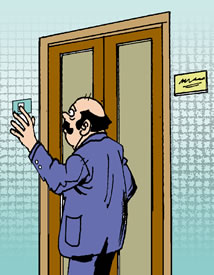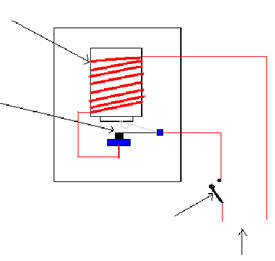
Dimdima
Online Children's Magazine from India

Dimdima
Online Children's Magazine from India

DOORBELLS are one of the most common devices you can find in almost every home. The doorbell works on the principle of Electromagnetism.
Different types of doorbells are available like buzzers, bells, or chimes that produce a Ding-Dong sound.
In a buzzer, a self-interrupting circuit is used. When the doorbell switch is pressed, current flows through the coil of the electromagnet. The electromagnet causes a magnetic field that pulls on one of the electrical contacts within the doorbell. (See Diagram) When the contact moves, the current through the electromagnet is stopped. This in turn means that there is no longer a magnetic field and the electrical contact drops back into its original position. Current can now flow through the electromagnet coil again and the above process is repeated several times every second so long as the switch remains pressed. The movement of the electrical contact back and forth creates the typical buzzer sound.
The bell system works exactly like the buzzer system except that the moving contact is connected to an arm, which strikes against a bell. This produces a ringing sound when the doorbell switch is pressed.
In both the above systems the doorbell will continue to make a sound so long as the switch is pressed. This can be irritating if the person at the door presses the switch and keeps it pressed until the door is opened. This problem is eliminated in the door chime.
The door chime is also called a Ding-Dong bell because of the characteristic sound it makes. It uses a special type of electromagnet called a solenoid. In a solenoid the electromagnet coil surrounds a metal piston, which is made of magnetic material like iron. When the doorbell switch is pressed, current passes through the electromagnet creating a magnetic field. This magnetism pulls the metal piston, which strikes against a metal strip and creates a “Ding” sound. The piston remains pressed against the metal strip as long as the switch is kept pressed. When the switch is released a spring pulls the piston back to its original position, making it strike against another metal strip. This creates the ‘Dong’ sound.
TYPICAL CONSTRUCTION OF A BUZZER
 Current through the coil creates a magnetic field which pulls on the moving contact. The circuit is broken, current stops flowing in the coil, and the moving contact drops back. The circuit is again complete and the cycle repeats.
Current through the coil creates a magnetic field which pulls on the moving contact. The circuit is broken, current stops flowing in the coil, and the moving contact drops back. The circuit is again complete and the cycle repeats.
EXPLORE MORE...
Get Help or Give Help.
- Do you have a Science Question?
- Post it here and get the answer.
- Some questions posted by others are not yet answered.
- View those questions and answer them.
Dimdima is the Sanskrit word for ‘drumbeat’. In olden days, victory in battle was heralded by the beat of drums or any important news to be conveyed to the people used to be accompanied with drumbeats.
Bharatiya Vidya Bhavan
K. M Munshi Marg,
Chowpatty, Mumbai - 400 007
email : editor@dimdima.com
Bharatiya Vidya Bhavan
505, Sane Guruji Marg,
Tardeo, Mumbai - 400 034
email : promo@dimdima.com
Dimdima.com, the Children's Website of Bharatiya Vidya Bhavan launched in 2000 and came out with a Printed version of Dimdima Magazine in 2004. At present the Printed Version have more than 35,000 subscribers from India and Abroad.